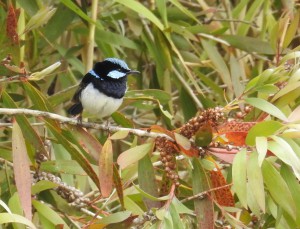A patch of forest may look like the ideal habitat for many wildlife species until we look more closely
-

Fairy-wrens usually disappear from areas where understory is destroyed
It may lack the understory shrubs needed by small, ground-foraging mammals, birds, reptiles and other creatures
- It may lack old trees with hollow branches suitable for nesting by possums, gliders, owls, native bees and other creatures.
- There may be plenty of eucalyptus, but not the right species for the koala to feed on
- The habitat structure may be fine but there is nothing fruiting in winter for the survival of fruit-eating animals during that lean season
- Similarly there may not be enough flowers for nectar-feeding creatures, especially in winter.
- It may be lacking over food sources such as the hill sheoak the glossy black cockatoo depends on, or various host plants for he caterpillars of local butterflies
- It may not be large enough for some species that need large home-ranges, such as quolls.
- It may be confined to dry hilltops, with little access to water during drought, and where eucalyptus leaves become too dry for koalas to digest properly (same applies to vegetation eaten by other species)
- It may be inhabited or visited frequently by feral animals such as cats and foxes.
to be continued …




